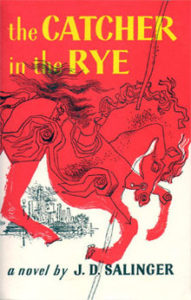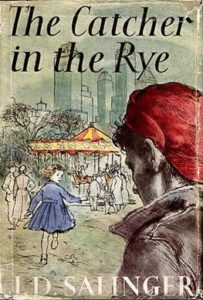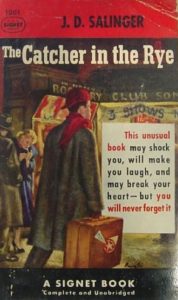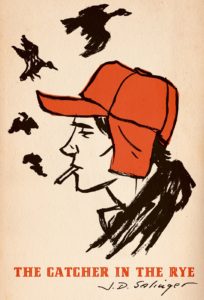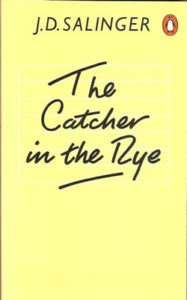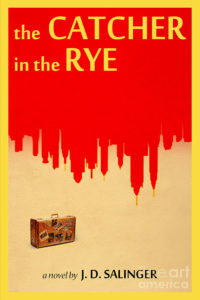Check out the very first reviews of The Catcher in the Rye.
“I was surrounded by phonies…They were coming in the goddam window.”
70 years ago today, The Catcher in the Rye first hit bookshelves across the US, and people still have some pretty strong opinions about J. D. Salinger’s groundbreaking debut. Die-hard fans and rabid haters are legion. Indeed, of all the mid-century American novels to stand the test of time, perhaps only On the Road provokes a comparably polarizing response among contemporary readers. Many argue that Catcher remains the quintessential story of teenage angst and alienation, as resonant and formative a text for today’s youth as it was in the 1950s; while no small amount of others, still pissed at being forced to write 11th grade English papers on the motivations of its, em, singular protagonist, resent the book’s exalted status as a foundation text in the modern American canon and staple of high school syllabi countrywide.
Love it or hate it, though, The Catcher in the Rye has endured (it still sells about a million copies a year, bringing its grand total to somewhere in the region of 73 million), and we felt that this auspicious publication anniversary merited some manner of retrospective. So here it is: a load of phonies from The New York Times, TIME, The New Yorker, and elsewhere writing about their impressions of Holden Caulfield and his New York odyssey way back in 1951.
*
“This girl Helga, she kills me. She reads just about everything I bring into the house, and a lot of crumby stuff besides. She’s crazy about kids. I mean stories about kids. But Hel, she says there’s hardly a writer alive can write about children. Only these English guys Richard Hughes and Walter de la Mare, she says. The rest is all corny. It depresses her. That’s another thing. She can sniff a corny guy or a phony book quick as a dog smells a rat. This phoniness, it gives old Hel a pain if you want to know the truth. That’s why she came hollering to me one day, her hair falling over her face and all, and said I had to read some damn story in The New Yorker. Who’s the author? I said. Salinger, She told me, J. D. Salinger. Who’s he? I asked. How should I know, she said, just you read it.
…
“That’s the way it sounds to me, Hel said, and away she went with this crazy book. The Catcher in the Rye. What did I tell ya, she said next day. This Salinger, he’s a short story guy. And he knows how to write about kids. This book though, it’s too long. Gets kind of monotonous. And he should’ve cut out a lot about these jerks and all at that crumby school. They depress me. They really do. Salinger, he’s best with real children. I mean young ones like old Phoebe, his kid sister. She’s a personality. Holden and little old Phoeb, Hel said, they kill me. This last part about her and Holden and this Mr. Antolini, the only guy Holden ever thought he could trust, who ever took any interest in him, and who turned out queer—that’s terrific. I swear it is.
You needn’t swear, Hel, I said. Know what? This Holden, he’s just like you. He finds the whole world’s full of people say one thing and mean another and he doesn’t like it; and he hates movies and phony slobs and snobs and crumby books and war. Boy, how he hates war. Just like you, Hel, I said. But old Hel, she was already reading this crazy Catcher book all over again. That’s always a good sign with Hel.”
–James Stern, The New York Times, July 15, 1951
“ ‘Some of my best friends are children,’ says Jerome David Salinger, 32. ‘In fact, all of my best friends are children.’ And Salinger has written short stories about his best friends with love, brilliance and 20-20 vision. In his tough-tender first novel, The Catcher in the Rye (a Book-of-the-Month Club midsummer choice), he charts the miseries and ecstasies of an adolescent rebel, and deals out some of the most acidly humorous deadpan satire since the late great Ring Lardner.
…
“For U.S. readers, the prize catch in The Catcher in the Rye may well be Novelist Salinger himself. He can understand an adolescent mind without displaying one.”
“Holden’s story is told in Holden’s own strange, wonderful language by J. D. Salinger in an unusually brilliant novel … Holden is bewildered, lonely, ludicrous and pitiful. His troubles, his failings are not of his own making but of a world that is out of joint. There is nothing wrong with him that a little understanding and affection, preferably from his parents, couldn’t have set right. Though confused and unsure of himself, like most 16-year-olds, he is observant and perceptive and filled with a certain wisdom. His minor delinquencies seem minor indeed when contrasted with adult delinquencies with which he is confronted.
Mr. Salinger, whose work has appeared in The New Yorker and elsewhere, tells a story well, in this case under the special difficulties of casting it in the form of Holden’s first-person narrative. This was a perilous undertaking, but one that has been successfully achieved. Mr. Salinger’s rendering of teen-age speech is wonderful: the unconscious humor, the repetitions, the slang and profanity, the emphasis, all are just right. Holden’s mercurial changes of mood, his stubborn refusal to admit his own sensitiveness and emotions, his cheerful disregard of what is sometimes known as reality are typically and heart breakingly adolescent.”
–Nash K. Burger, The New York Times, July 16, 1951
“The book as a whole is disappointing, and not merely because it is a reworking of a theme that one begins to suspect must obsess the author. Holden Caulfield, the main character who tells his own story, is an extraordinary portrait, but there is too much of him…
In the course of 277 pages, the reader wearies of [his] explicitness, repetition and adolesence, exactly as one would weary of Holden himself. And this reader at least suffered from an irritated feeling that Holden was not quite so sensitive and perceptive as he, and his creator, thought he was. In any case he is so completely self-centered that the other characters who wander through the book—with the notable exception of his sister Phoebe—have nothing like his authenticity … In a writer of Salinger’s undeniable talent, one expects something more.”
–Anne L. Goodman, The New Republic, 1951
“A young man possessed of a young man’s vigor and callowness and an old man’s jaundiced eye rip-snorts his way through this raucous novel and by turns delights, frightens, shocks you and leaves you close to the tears into which he himself bursts as the climax to his mad escapade.
…
“He tells the story himself; tough and tender, frown and smile, bitter and sweet. It’s a sort of lost week end; it’s a boy who can’t go home again; he belongs to a lost generation and lives in a world he never made. It reminds us of significant conclusions reached by other writers in our time. But besides that, and despite your hoots of laughter at Holden’s indomitable speech, this is in essence the tragic story of a problem child, unless indeed it’s an indictment of a problem world. Month in, month out, novels don’t come much better.”
–The Associated Press, July 29, 1951
“Mr. Salinger’s brilliant, funny, meaningful novel is written in the first person. Holden Caulfield is made to tell his own story, in his own strange idiom. Holden is not a normal boy. He is hypersensitive and hyper-imaginative (perhaps these are synonymous). He is double-minded. He is inexorably self-critical; at various times, he refers to himself as yellow, as a terrible liar, a madman, a moron.
…
“The literalness and innocence of Holden’s point of view in the face of the tremendously complicated and often depraved facts of life make for the humor of this novel: serious haggles with belligerent taxi-drivers; abortive conversational attempts with a laconic prostitute in a hurry; an ‘intellectual’ discussion with a pompous and phony intellectual only a few years older than himself; an expedition with Sally Hayes, which is one of the funniest expeditions, surely, in the history of juvenilia. Holden’s contacts with the outside world are generally extremely funny. It is his self-communings that are tragic and touching—a dark whirlpool churning fiercely below the unflagging hilarity of his surface activities.”



